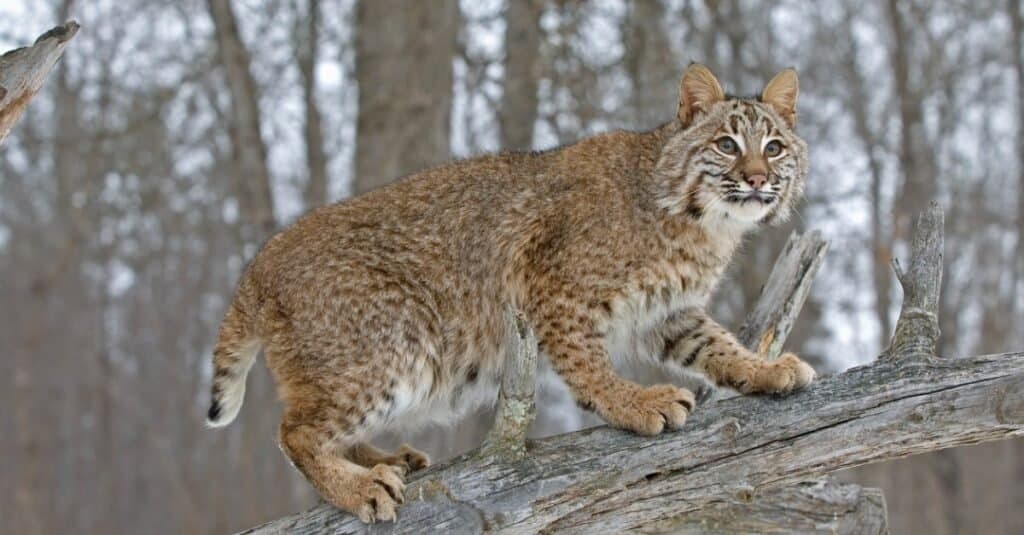Bobcats are nocturnal wildcats with adorable faces and quiet personalities. Although sometimes they accidentally wander into noisy neighborhoods, they typically stay to themselves.
Bobcats are native to North and South America and they have steady populations. However, in some areas like New Jersey, their population is declining. Interestingly, bobcats can be found in 47 states, but not in Delaware, Alaska, or Hawaii.
These medium-sized cats have interesting sleeping habits. Although we don’t see them often, they are very common. So where do they sleep? When are they active?
Keep reading to find out more about where bobcats sleep and more fun facts about this wild feline.
Where Do Bobcats Sleep?

Bobcats sleep in dens.
© Johann Knox/Shutterstock.com
Bobcats have many resting areas. They are not picky though but build multiple dens. Bobcats are very territorial and live alone, except mother bobcats take care of their kittens. But when their kittens age, they live alone again. Bobcats sleep in dens, some they find, and others they build slowly.
However, it’s more common for a bobcat to find a cozy den in the area they mark. Their cozy den can be a hollow tree, a fallen log, a cave, a bush, or a hole in the ground. Sometimes bobcats sleep on top of tree branches they climb, but this usually isn’t a permanent den or home.
What Time of Day Are Bobcats Active?
Bobcats only sleep for about 2-3 hours in one sitting, but they sleep multiple times a day. They are most active during dawn and dusk. However, they can be active all hours of the day and night since they wake up frequently.
However, bobcats prefer hunting for their food in darkness as it acts like a layer of protection since they can blend in and use their excellent hearing and sight.
Where Do Bobcats Like to Live?

You can find bobcats in wetlands, deserts, and mountains.
©Laurie E Wilson/Shutterstock.com
You can find these animals basically anywhere in North America. They thrive in warmer clients and wooded forests, however, you can also find them hiding in the mountains. Bobcats commonly live in Mexico and Canada. Fun fact, their size varies depending on where they live.
For example, bobcats living in the North, including Canada are larger and fluffier than bobcats living in the southern U.S and Mexico. Although bobcats prefer warmer regions, they also live in wetlands, deserts, mixed forests, and coastal swamps.
It’s unlikely you will find a bobcat in a large and open meadow since there is no protection.
Lifespan: How Long do Bobcats Live?
Young bobcats tend to grow fairly quickly during the first six months of their life, their average lifespan is about 7 years. Male bobcats may not be fully grown until about a year and a half and females need a little extra time and tend to become fully grown at around two years old.
Although the average lifespan of a bobcat is seven years old, bobcats have been known to live up to 12 years in the wild.
Do Bobcats Stay In One Area?
Bobcats are habitual animals that live solitary lives. They mark their area and stay there. However, the area can be as large as six miles long. They typically stay there their whole lives, unless they are forced out by harsh conditions like snow or destruction from hurricanes.
Even bobcat mothers with kittens stay within one mile of their den when nursing. Some bobcats hold on to two or three territories at the same time, but they are usually close to each other. There are also multiple dens in the same territory.
What Do Bobcats Eat?

Bobcats eat smaller mammals.
©Rejean Bedard/Shutterstock.com
Bobcat diets are stable. They quietly hunt and prowl for small mammals, but occasionally will hunt down vulnerable feral cats or dogs. However, it’s more common to see them feasting on squirrels, birds, rodents, and chickens. Bobcats hunt for these animals by relying on their sight and hearing. They crouch low to the ground, waiting for the right moment to strike.
Interestingly bobcats wait as they crouch for their prey to get closer before they quickly pounce. After killing and eating the animal, they bury the remains under leaves, dirt, and twigs. Bobcats aren’t picky eaters, but they do prefer fresh meat and need at least two pounds of food per day.
What Do You Do if You See a Bobcat in Your Yard?
Although uncommon, some bobcats wander into backyards and neighborhoods, feeding on small rodents. Remember, they move wherever their main food source moves. If this happens to be in your backyard, take a step back.
Bobcats leave when they are done hunting and go back to their territory, preferring to sleep in a den than in your backyard. However, if your pet is out or they don’t leave right away, make as much noise as possible. You can do this by clapping your hands or stomping your feet. The abruptness should scare away the medium-sized wild cat.
If you are inside and have access, you can also turn on the sprinkles or your hose. Wet the bobcat, they will run away. Honestly, though, even if a bobcat is in your backyard, they pose very little threat since they aren’t known to attack humans. While it’s unlikely they won’t attack you, it’s still not safe to run or try to pet a wild bobcat. They aren’t pets and can react negatively when they feel threatened.

Bobcats are some of nature’s most fearless predators, making them one of the few native creatures bold enough to kill and eat venomous snakes.
©iStock.com/JohnPitcher
The photo featured at the top of this post is © Victor Arita/Shutterstock.com
Thank you for reading! Have some feedback for us? Contact the AZ Animals editorial team.







